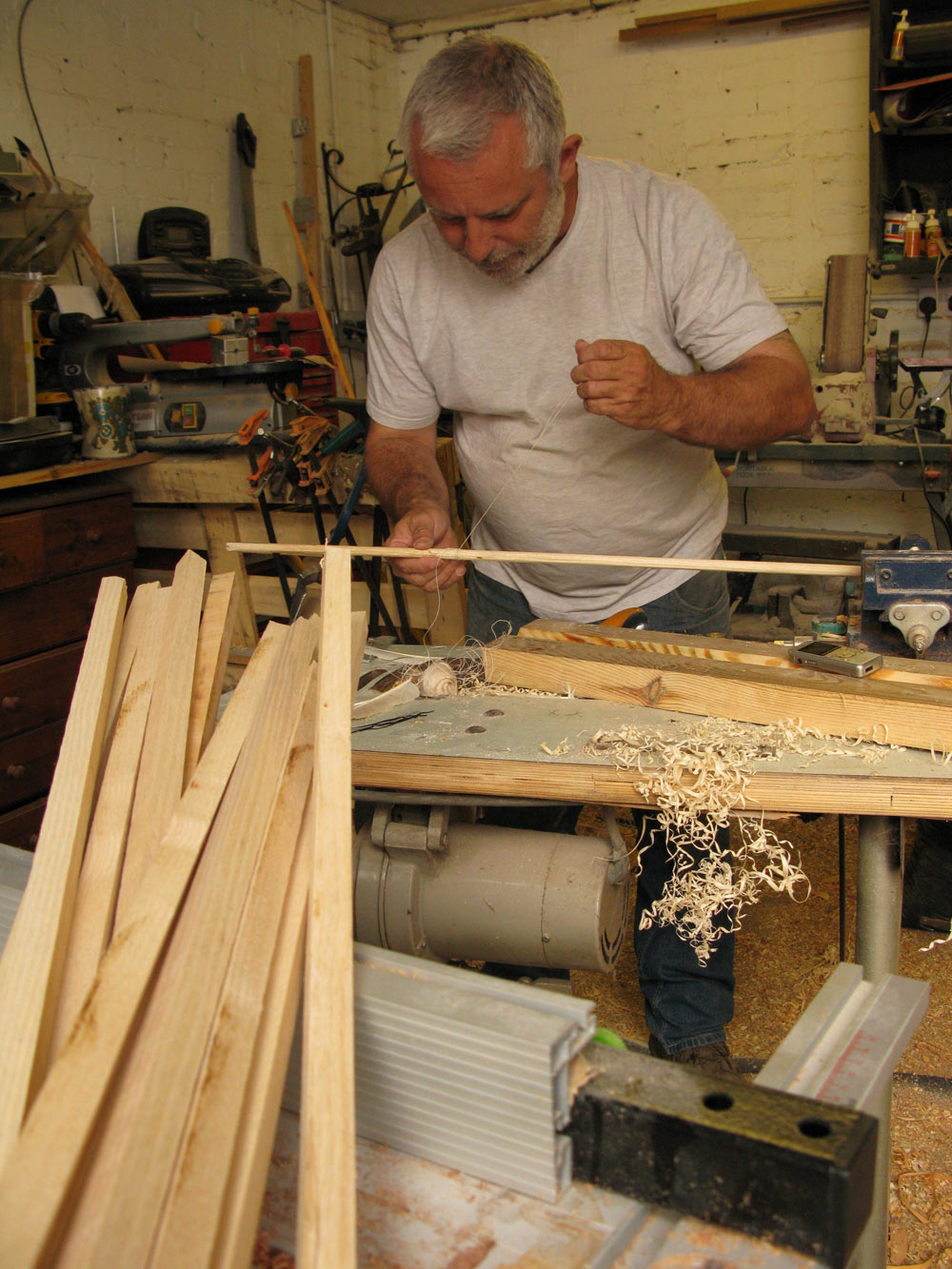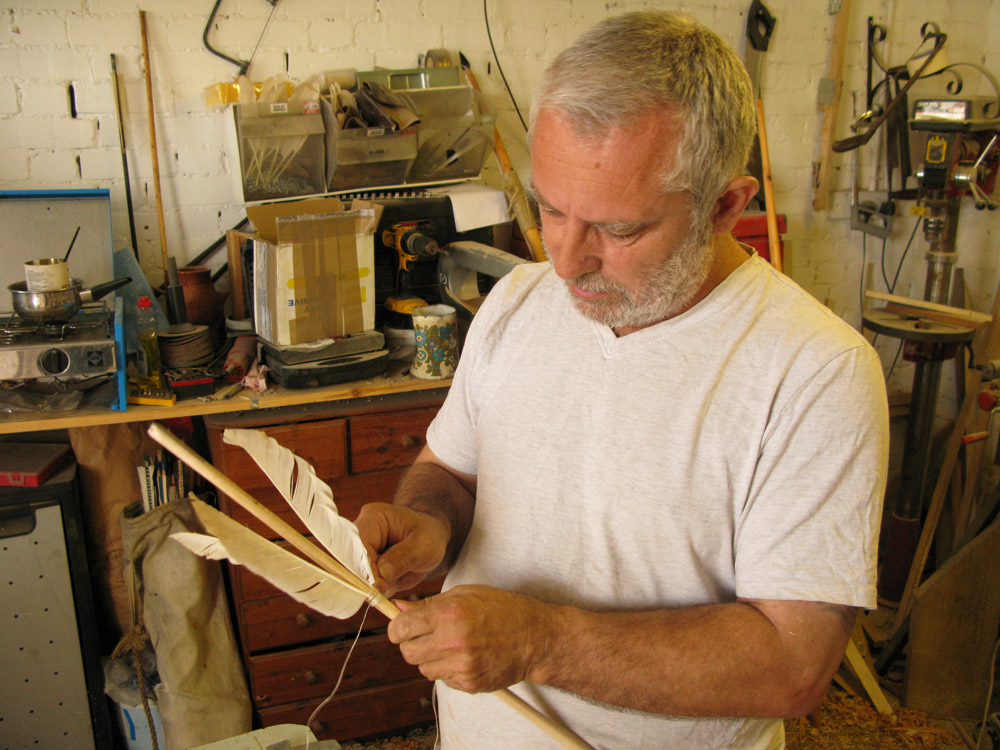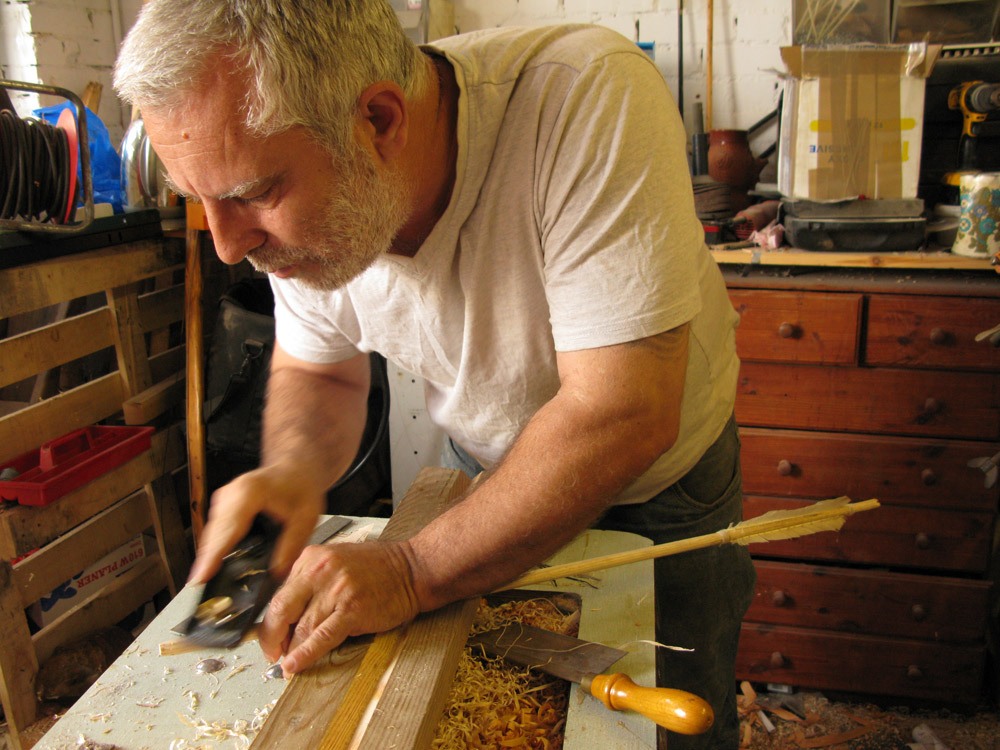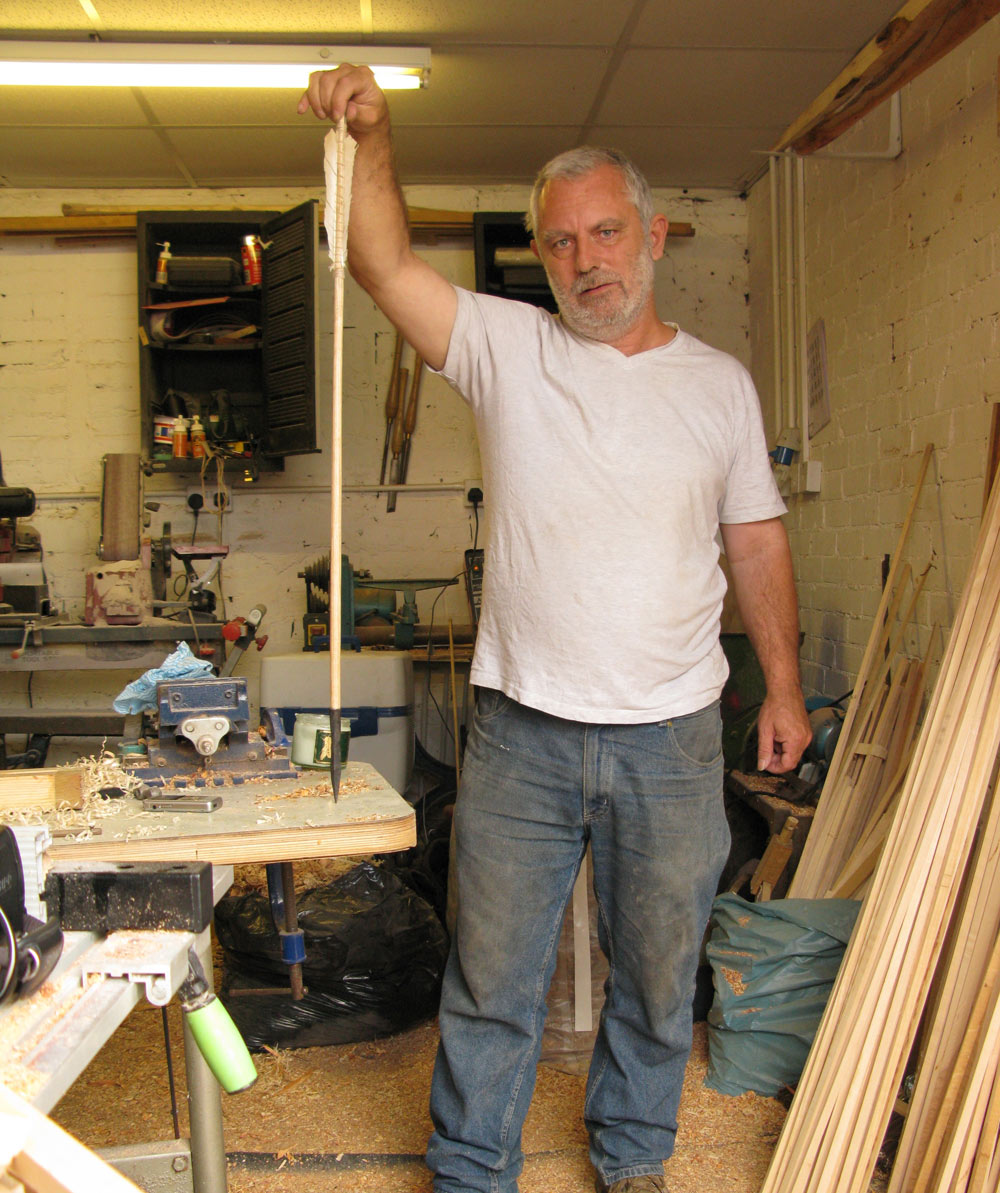Tom Mareschall
The following extract is taken from ‘The Man Who Made Things Out of Trees’.
‘Ash has many qualities that make it ideal for arrow shafts, but the fact that it grows almost everywhere and it grows like mad has to be significant,’ Tom Mareschall said, taking the first bundle of wood out of my arms. He was broad and stout with a pate of white hair and a closely cropped beard. A tattoo curled out beneath a grey T-shirt sleeve on his hulking upper right arm. As you might expect of an artisan bowyer, arrow-maker and blacksmith, he had powerful hands with great, meaty fingers. He spoke with a deep voice, from the corner of his mouth. There was a hint of an Essex brogue and a tiny glint of menace in his dark, heavily set eyes. If it all kicked off, I thought, he was a man you would want by your side. When we had finished unloading my car, I glanced around the workshop, a brick shed beside a farm in undulating Essex countryside. A dozen bows in various shapes and lengths, from six-foot longbows down to kids’ hunting bows, lay on racks across the window. Yew bow blanks and half-worked yew bows leant against the whitewashed walls in gangs.
‘Ash has many qualities that make it ideal for arrow shafts, but the fact that it grows almost everywhere and it grows like mad has to be significant,’ Tom Mareschall said, taking the first bundle of wood out of my arms. He was broad and stout with a pate of white hair and a closely cropped beard. A tattoo curled out beneath a grey T-shirt sleeve on his hulking upper right arm. As you might expect of an artisan bowyer, arrow-maker and blacksmith, he had powerful hands with great, meaty fingers. He spoke with a deep voice, from the corner of his mouth. There was a hint of an Essex brogue and a tiny glint of menace in his dark, heavily set eyes. If it all kicked off, I thought, he was a man you would want by your side. When we had finished unloading my car, I glanced around the workshop, a brick shed beside a farm in undulating Essex countryside. A dozen bows in various shapes and lengths, from six-foot longbows down to kids’ hunting bows, lay on racks across the window. Yew bow blanks and half-worked yew bows leant against the whitewashed walls in gangs.
I had brought 130 arrow blanks, oblong sticks measuring nine sixteenths of an inch x nine sixteenths of an inch x thirty-one inches, all sawn from a single plank from near the outside of the trunk of my tree. In return for the wood, Tom had agreed to show me how to make a medieval arrow, in as near a traditional way as he could. Tom put the kettle on and began inspecting the wood.
He placed one of my oblong sticks of ash on a shooting board, a piece of flat wood with a recess in the surface, blocked at one end. With a hand plane, he leant over the table and began to shave off the long edges. Ringlets gathered at the end of the board in a pile. Tom was already warming up. He stood straight, took a slurp of coffee and held the ash stick up. It was now octagonal. He placed it back in the shooting blank and repeated the process, shaving the eight edges off. Curl by curl the square stick was transformed into a round shaft.
He placed one of my oblong sticks of ash on a shooting board, a piece of flat wood with a recess in the surface, blocked at one end. With a hand plane, he leant over the table and began to shave off the long edges. Ringlets gathered at the end of the board in a pile. Tom was already warming up. He stood straight, took a slurp of coffee and held the ash stick up. It was now octagonal. He placed it back in the shooting blank and repeated the process, shaving the eight edges off. Curl by curl the square stick was transformed into a round shaft.
He held it up to eye level and squinted at it. ‘We’ve now got an approximately round shaft. Not bad, actually. You can see the grain clearly. Nice and straight. This’ll make a decent arrow. Feel it, it’s got a bit of weight to it,’ Tom said.
For tens of thousands of years, humans have fashioned innumerable different species of wood into shafted projectiles. During the late Middle Ages, though, when the longbow reached the apogee of its prowess as the deadliest weapon in European warfare, and the aerodynamic design and technology of arrows reached a fearsome pinnacle, then the favoured wood for making arrows was ash.
For tens of thousands of years, humans have fashioned innumerable different species of wood into shafted projectiles. During the late Middle Ages, though, when the longbow reached the apogee of its prowess as the deadliest weapon in European warfare, and the aerodynamic design and technology of arrows reached a fearsome pinnacle, then the favoured wood for making arrows was ash.
Edward I, an accomplished general when he became King of England in 1272, was arguably the first monarch to fully appreciate the military capabilities of the longbow. Campaigning in Wales in the 1280s, Welsh longbowmen took a heavy toll on Edward’s army, convincing him of the need to have them within his own ranks. Between around 1300 and 1550, the longbow was the standard infantry weapon in the English army.
During this period, archery was as commonplace a pastime as football is today. In the fourteenth century, archery practice on Sundays was made compulsory for able-bodied men and boys aged from eight to sixty years old, by a series of royal decrees. On feast days, tournaments with prizes were held, as a means for sheriffs to assess the competence of the archers within their community.
During this period, archery was as commonplace a pastime as football is today. In the fourteenth century, archery practice on Sundays was made compulsory for able-bodied men and boys aged from eight to sixty years old, by a series of royal decrees. On feast days, tournaments with prizes were held, as a means for sheriffs to assess the competence of the archers within their community.
Most towns and villages had an archery butt, often in a field beside the churchyard. To this day, many villages in England and Wales still have a place called ‘butt field’. When I was growing up, I played rugby at a ground called The Butts. Tom told me that at the back door of the church of St Edward, King and Martyr, next to Corfe Castle in Dorset, there are marks in the walls where the archers used to sharpen their arrows before practice, 500 or more years ago. The object of enforced practice was to develop and maintain a national pool of accomplished archers who were ready for military service at any time. It worked. During the Hundred Years War, the English military was able to call upon a large cadre of fit, strong, well-trained bowmen all firing technologically advanced arrows from powerful longbows.
The tactics employed by Edward III, and later Henry V, during the Hundred Years War – positioning heavily armed soldiers on foot alongside archers, in defensive set battles – proved devastating against the feudal cavalry of the Valois kings of France. These tactics lead to famous, against the odds victories. The names of these battles still trip off the tongues of English schoolchildren, six centuries later – Agincourt, Poitiers and, perhaps the engagement most indelibly linked to the prowess of archers, Crécy.
The tactics employed by Edward III, and later Henry V, during the Hundred Years War – positioning heavily armed soldiers on foot alongside archers, in defensive set battles – proved devastating against the feudal cavalry of the Valois kings of France. These tactics lead to famous, against the odds victories. The names of these battles still trip off the tongues of English schoolchildren, six centuries later – Agincourt, Poitiers and, perhaps the engagement most indelibly linked to the prowess of archers, Crécy.




